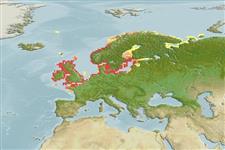Actinopterygii (ray-finned fishes) >
Gasterosteiformes (Sticklebacks and seamoths) >
Gasterosteidae (Sticklebacks and tubesnouts)
Etymology: Spinachia: Derived from Latin, spine = thorn (Ref. 45335).
Environment / Climate / Range
Ecology
Marine; brackish; benthopelagic; non-migratory. Temperate, preferred ?; 71°N - 43°N, 11°W - 55°E
Northeast Atlantic: north-western Europe.
Size / Weight / Age
Maturity: Lm ? range ? - ? cm
Max length : 22.0 cm SL male/unsexed; (Ref. 4119)
Dorsal
spines
(total): 14 - 17. Front of body brassy-yellow in the male, with larger pectoral fins than in the female (Ref. 35388).
Adults live solitary or in pairs in weedy, shallow coastal areas (Ref. 4119). Feed on small invertebrates (Ref. 4119). Males build a nest from algae and debris, using kidney excrete as glue. Spawning season is May to June. Females deposit 150 - 200 eggs in the nest and often die shortly afterwards (Ref. 9900). Males care for and defend the nest. Offsprings reach maturity in one year (Ref. 4645).
Males build, guard and aerate the nest where the eggs are deposited (Ref. 205). Also Ref. 53335.
Muus, B.J. and P. Dahlström, 1974. Collins guide to the sea fishes of Britain and North-Western Europe. Collins, London, UK. 244 p. (Ref. 173)
IUCN Red List Status (Ref. 115185)
CITES (Ref. 94142)
Not Evaluated
Threat to humans
Harmless
Human uses
Fisheries: of no interest
More information
ReferencesAquacultureAquaculture profileStrainsGeneticsAllele frequenciesHeritabilityDiseasesProcessingMass conversion
Tools
Can't connect to MySQL database fbquizv2. Errorcode: Too many connections
